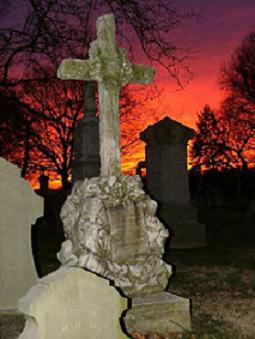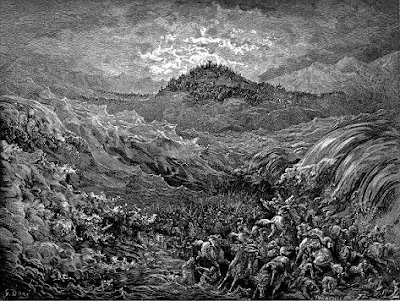copyright 2008 by Gary L. Pullman
To paraphrase Elizabeth Barrett Browning, in this and the next couple of posts, we ask of life, “How do I fear thee? Let me count the ways.”
Animals. Why do they frighten? The answer is simple. They’re faster and stronger than we are; they have greater stamina than we have; they have teeth and fangs or other offensive weaponry; and, wild, they are unbothered by the niceties of civilization and culture. In addition, humanity’s relationship, as it were, with the beasts has been as much one of exploitation on our part as it has been one of faithful service on the part of those which we’ve been able, as we say, from our point of view, to “domesticate.” There may be, we fear, as much loathing as loving in the animals’ feelings toward us, their presumed “masters.” Among those that are not “domesticated,” there is not the least pretense of affection for us; there is but the “gaze as blank and pitiless as the sun” of William Butler Yeats’ “rough beast” that, “it’s hour come round at last,/ Slouches toward Bethlehem to be born.” Occasionally, wild animals that circus performers or magicians believe they have “domesticated” cripple or kill their “masters,” as the white tiger mauled the Las Vegas magician Roy Horn, formerly of Siegfried and Roy. In one of The Chronicles of Narnia novels, one of C. S. Lewis’ characters warns others that Aslan “is not a tame lion.” The same may be said of all other wild animals as well. Exploitation, whether of nature, animals, or other human beings, is a basis, in horror fiction, as in life, for fear.

Source: U .S. Government Photos and Graphics
Bats. Why do they frighten? The answer is simple. They’re faster than we are; they may have greater stamina than we have; they have talons and teeth; and, wild, they are unbothered by the niceties of civilization and culture. They’re associated, traditionally, with vampires. They’re also hybrid creatures--at least in the popular imagination--part mouse and part bird, as it seems, and, therefore, an anomaly, a perversion, as it were, of nature. They can’t even get the wings right: they’re leathery rather than feathery, and the damned things can’t see; they use a bizarre “radar sense.” Perversity, real or apparent, is a basis, in horror fiction, as in life, for fear.

Source: U. S. Government Photos and Graphics
Cemeteries. Why do they frighten? The answer is simple. They are full of dead bodies, entombed or buried, but dead bodies, nevertheless, or ashes. Those buried are buried for a reason, which has little to do with public sanitation and everything to do with their designation as “human remains,” the physical decay of the corpse, and the revelation that, in the end, we may be nothing more than bones and dust, which makes life both rather horrible and absurd. Cemeteries, like the dead bodies or human ashes they contain, the remains or the cremains, are, as mementoes of death, a basis, in horror fiction, as in life, for fear.
Demons. Why do they frighten? The answer is simple. They represent the embodiment of evil. Whether they are legion or represent only a particular vice or depravity, they are malevolence incarnate. Often, they are depicted with claws and fangs. They may have fur and tails. They may have horns and hooves. Bestial in appearance, they are frightening because they’re faster and stronger than we are; they have greater stamina than we have; they have teeth and fangs or other offensive weaponry; and, wild, they are unbothered by the niceties of civilization and culture. They are enemies of God himself and tempt men and women to sin and, ultimately, to denounce God and to be damned for eternity to hell. Demons frighten because they represent the powerful temptation to defy God, surrendering one’s will to self-destructive impulses. The pursuit of the inner demons of self-destructive behavior is a basis, in horror fiction, as in life, for fear.
Evil. Why does it frighten? The answer is simple. Evil is a mystery. It is an ambiguity and an inscrutability, and the incomprehensible and the irrational are seductive. Evil is a song sung by more than a few sirens. Evil is dark. It is fascinating. It is compelling. It is insistent and enchanting. It is hypnotic. It is spellbinding. It captivates because it has no center, no self, no soul, and its shape is ever changing, always shifting, becoming whatever one lacks but wants and should not have. Its root is pride, but it often puts forth tendrils of envy and leaves of spite. Evil’s protean ability to be all things to all people is a basis, in horror fiction, as in life, for fear.
Frogs. Why do they frighten? The answer is simple. They don’t. That is, they don’t frighten many, but they do frighten some, and, if we let them represent not merely themselves but all amphibians (let’s throw in reptiles, too, for good measure), these creatures are frightening to the
majority of people, for those who do not fear frogs are likely to fear lizards or turtles or snakes or eyes of newt. These creatures are primordial in appearance. They suggest the earliest of beasts, the hopping and crawling and creeping ones as much as the running ones, and, as such, they seem to suggest the least evolved life forms, those closest, as it were, to the primordial soup. They’re living embodiments of the days before we existed, suggesting that a world without us is possible--perhaps, someday, even probable. They’re also suggestions that we, who pride ourselves upon having evolved to the very pinnacle of nature, may perhaps regress to the level at which we are, once again, subhuman creatures whose only act of communication is the primal scream. Reptiles and amphibians (and imaginary and imaginative creatures derived from them), represented here as frogs, are reminders of our animal origins and of the possibility that we could regress instead of progressing and are, therefore, a basis, in horror fiction, as in life, for fear.

In this drawing by Gustave Dore, God gets cranky, drowning the Egyptians in the Red Sea he parted to facilitate Moses' escape with the Hebrews
God. Why does he frighten? The answer is simple. God is not only powerful, but he is also
all-powerful. There is no recourse against his will. As Alexander Pope succinctly phrased the matter: “Man proposes; God disposes.” We are all in the hands of God, like it or not, and his will is our fate. Some fates, we understand, are more pleasant than others, but ours, whatever they may prove to be, are chosen for us, are, in fact, assigned to us from the foundation of the world. Free will is an absurdity and an illusion. God is sovereign, and we are his subjects. God is love, but, sometimes, from the human point of view, love can seem cruel, for the ways of God are not the ways of man. It can be, as Jonathan Edwards said, “a terrible thing to fall into the hands of the living God,” and, if anything, it is his servants who suffer the most. God is executing his will, not ours. God is a transcendent and wholly other power against which nothing avails unless he suffers it to do so, and it can never be known with certainty what he will suffer and what he will not, and such uncertainty and dependency upon the omnipotent and wholly other is a basis, in horror fiction, as in life, for fear.
Hell. Why does it frighten? The answer is simple. Hell is nowhere. It is the end of the line. It is endless and eternal futility. It is the “vanity of vanities,” the bottomless pit of despair, an existence apart from the ground of being, from being-itself, from God, the creator and the sustainer of life, of meaning, of purpose, of value, and of love. It is an outer darkness of death-in-life, of meaninglessness, of purposelessness, of worthlessness, of nothingness. “Abandon hope all ye who enter herein,” Dante’s portal to hell warned. Existential meaninglessness is a basis, in horror fiction, as in life, for fear.

Source: U. S. Government Photos and Graphics
Ice. Why does it frighten? The answer is simple. It freezes. It makes frozen objects brittle. According to the History Channel’s series
Ice Road Truckers, even steel, when it is frozen, can snap like a rubber band under pressure. One episode, in fact, shows a thick chain shatter. Truck engines, in the Alaskan wilderness, must be kept running overnight when the temperature is low enough, and equipment that is idle too long may refuse to start. Ice can also snap large branches from mighty oaks, and its weight can crush a roof. Although strong--the diesel big rigs of
Ice Road Truckers travel upon highways that are, to a large extent, nothing more than rivers and an ocean that have become solid ice--ice remains treacherous. It can cause vehicles to skid out of control or to plummet through its thinner parts, into a watery grave. Ice can also cause a body to freeze to death, despite layered clothing, heavy boots and coats, and shelter from the storm. Ice is symbolic of a cold nature, of a hostile and inhospitable temperament, of a lack of love and compassion, of the inability or refusal to sympathize and empathize. For all these reasons, and, especially, because ice is treacherous, it is a basis, in horror fiction, as in life, for fear.
In the next post, additional bases for fear will be identified and considered, but, ‘ere we part, let’s summarize our findings with regard to the nine bases of fear that were listed in this post:
- Exploitation, whether of nature, animals, or other human beings, is a basis, in horror fiction, as in life, for fear.
- Perversity, real or apparent, is a basis, in horror fiction, as in life, for fear.
- Cemeteries, like the dead bodies or human ashes they contain, the remains or the cremains, are, as mementoes of death, a basis, in horror fiction, as in life, for fear.
- The pursuit of the inner demons of self-destructive behavior is a basis, in horror fiction, as in life, for fear.
- Evil’s protean ability to be all things to all people is a basis, in horror fiction, as in life, for fear.
- Reptiles and amphibians (and imaginary and imaginative creatures derived from them), represented here as frogs, are reminders of our animal origins and of the possibility that we could regress instead of progressing and are, therefore, a basis, in horror fiction, as in life, for fear.
- God is a transcendent and wholly other power against which nothing avails unless he suffers it to do so, and it can never be known with certainty what he will suffer and what he will not, and such uncertainty and dependency upon the omnipotent and wholly other is a basis, in horror fiction, as in life, for fear.
- Existential meaninglessness is a basis, in horror fiction, as in life, for fear.
- Because ice is treacherous, it is a basis, in horror fiction, as in life, for fear.







